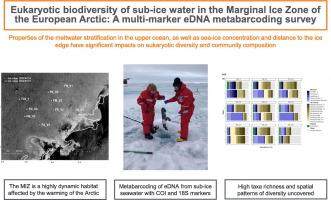Eukaryotic biodiversity of sub-ice water in the marginal ice zone of the European Arctic: A multi-marker eDNA metabarcoding survey
IF 8
1区 环境科学与生态学
Q1 ENVIRONMENTAL SCIENCES
引用次数: 0
Abstract
The effects of climate change, including warming waters, loss of sea ice habitat and the resulting changes in primary production, are inducing shifts in marine communities across the Arctic Ocean. The Arctic marginal ice zone (MIZ) is a highly dynamic ecosystem and is a transition zone between pack ice and the open ocean. It is habitat for a wide range of organisms, including sympagic and pelagic taxa, all of which are affected by the changing physical dynamics of the MIZ. Here we use a multi-marker (18S rRNA V1–2 and COI Leray-XT) approach to investigate eukaryotic biodiversity of the upper water column in this understudied habitat. Environmental DNA (eDNA) was sequenced from seawater samples collected directly beneath the sea ice and at a depth of 5 m, sourced from ice floes representing different ice regimes. To explore the abiotic factors influencing under-ice diversity, we combined satellite-derived environmental data with simultaneous in situ hydrographic measurements. Our analysis identified a range of sympagic and pelagic metazoans, along with primary producers typical of the region, as well as substantial uncharacterised diversity. Alpha diversity indices were higher immediately below the ice, and community composition differed across depths and ice floe stations. We show that the properties of the meltwater stratification in the upper ocean, along with sea ice concentration and distance to the ice edge, significantly shape eukaryotic diversity and community composition. These findings highlight the effectiveness of eDNA metabarcoding for monitoring sub-ice communities and enhance our understanding of eukaryotic biodiversity in the MIZ.

欧洲北极边缘冰带冰下水的真核生物多样性:多标记eDNA元条形码调查
气候变化的影响,包括海水变暖、海冰栖息地的丧失以及由此导致的初级生产的变化,正在引起整个北冰洋海洋群落的变化。北极边缘冰带(MIZ)是一个高度动态的生态系统,是浮冰和开放海洋之间的过渡地带。它是各种生物的栖息地,包括同栖和远洋分类群,所有这些生物都受到MIZ不断变化的物理动态的影响。本文采用多标记(18S rRNA V1-2和COI lray - xt)方法对该生境上层水体的真核生物多样性进行了研究。环境DNA (eDNA)是从直接在海冰下方和5米深处收集的海水样本中测序的,这些样本来自代表不同冰况的浮冰。为了探索影响冰下多样性的非生物因素,我们将卫星获取的环境数据与同时进行的原位水文测量相结合。我们的分析确定了一系列共生和远洋后生动物,以及该地区典型的初级生产者,以及大量未表征的多样性。α多样性指数在冰下较高,群落组成在不同深度和浮冰站存在差异。研究表明,上层海洋融水分层的特性,以及海冰浓度和到冰缘的距离,显著地影响了真核生物的多样性和群落组成。这些发现突出了eDNA元条形码在监测亚冰群落方面的有效性,并增强了我们对MIZ真核生物多样性的认识。
本文章由计算机程序翻译,如有差异,请以英文原文为准。
求助全文
约1分钟内获得全文
求助全文
来源期刊

Science of the Total Environment
环境科学-环境科学
CiteScore
17.60
自引率
10.20%
发文量
8726
审稿时长
2.4 months
期刊介绍:
The Science of the Total Environment is an international journal dedicated to scientific research on the environment and its interaction with humanity. It covers a wide range of disciplines and seeks to publish innovative, hypothesis-driven, and impactful research that explores the entire environment, including the atmosphere, lithosphere, hydrosphere, biosphere, and anthroposphere.
The journal's updated Aims & Scope emphasizes the importance of interdisciplinary environmental research with broad impact. Priority is given to studies that advance fundamental understanding and explore the interconnectedness of multiple environmental spheres. Field studies are preferred, while laboratory experiments must demonstrate significant methodological advancements or mechanistic insights with direct relevance to the environment.
 求助内容:
求助内容: 应助结果提醒方式:
应助结果提醒方式:


